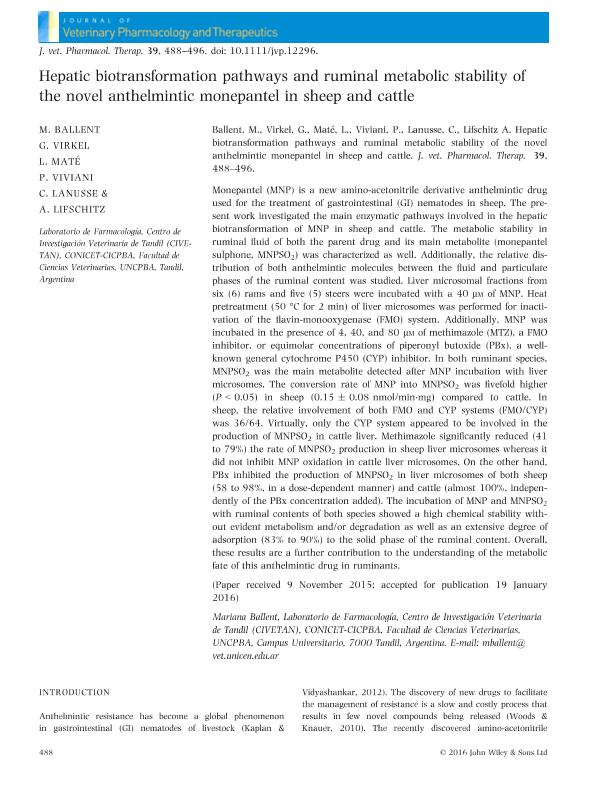Artículo
Hepatic biotransformation pathways and ruminal metabolic stability of the novel anthelmintic monepantel in sheep and cattle
Ballent, Mariana ; Virkel, Guillermo Leon
; Virkel, Guillermo Leon ; Maté, María Laura
; Maté, María Laura ; Viviani, Paula
; Viviani, Paula ; Lanusse, Carlos Edmundo
; Lanusse, Carlos Edmundo ; Lifschitz, Adrian Luis
; Lifschitz, Adrian Luis
 ; Virkel, Guillermo Leon
; Virkel, Guillermo Leon ; Maté, María Laura
; Maté, María Laura ; Viviani, Paula
; Viviani, Paula ; Lanusse, Carlos Edmundo
; Lanusse, Carlos Edmundo ; Lifschitz, Adrian Luis
; Lifschitz, Adrian Luis
Fecha de publicación:
02/2016
Editorial:
Wiley Blackwell Publishing, Inc
Revista:
Journal of Veterinary Pharmacology and Therapeutics
ISSN:
0140-7783
Idioma:
Inglés
Tipo de recurso:
Artículo publicado
Clasificación temática:
Resumen
Monepantel (MNP) is a new amino-acetonitrile derivative anthelmintic drug used for the treatment of gastrointestinal (GI) nematodes in sheep. The present work investigated the main enzymatic pathways involved in the hepatic biotransformation of MNP in sheep and cattle. The metabolic stability in ruminal fluid of both the parent drug and its main metabolite (monepantel sulphone, MNPSO2) was characterized as well. Additionally, the relative distribution of both anthelmintic molecules between the fluid and particulate phases of the ruminal content was studied. Liver microsomal fractions from six (6) rams and five (5) steers were incubated with a 40 μm of MNP. Heat pretreatment (50 °C for 2 min) of liver microsomes was performed for inactivation of the flavin-monooxygenase (FMO) system. Additionally, MNP was incubated in the presence of 4, 40, and 80 μm of methimazole (MTZ), a FMO inhibitor, or equimolar concentrations of piperonyl butoxide (PBx), a well-known general cytochrome P450 (CYP) inhibitor. In both ruminant species, MNPSO2 was the main metabolite detected after MNP incubation with liver microsomes. The conversion rate of MNP into MNPSO2 was fivefold higher (P < 0.05) in sheep (0.15 ± 0.08 nmol/min·mg) compared to cattle. In sheep, the relative involvement of both FMO and CYP systems (FMO/CYP) was 36/64. Virtually, only the CYP system appeared to be involved in the production of MNPSO2 in cattle liver. Methimazole significantly reduced (41 to 79%) the rate of MNPSO2 production in sheep liver microsomes whereas it did not inhibit MNP oxidation in cattle liver microsomes. On the other hand, PBx inhibited the production of MNPSO2 in liver microsomes of both sheep (58 to 98%, in a dose-dependent manner) and cattle (almost 100%, independently of the PBx concentration added). The incubation of MNP and MNPSO2 with ruminal contents of both species showed a high chemical stability without evident metabolism and/or degradation as well as an extensive degree of adsorption (83% to 90%) to the solid phase of the ruminal content. Overall, these results are a further contribution to the understanding of the metabolic fate of this anthelmintic drug in ruminants.
Palabras clave:
Monepantel
,
Biiotransformation
,
Ruminal Stability
,
Ruminants
Archivos asociados
Licencia
Identificadores
Colecciones
Articulos(CCT - TANDIL)
Articulos de CTRO CIENTIFICO TECNOLOGICO CONICET - TANDIL
Articulos de CTRO CIENTIFICO TECNOLOGICO CONICET - TANDIL
Articulos(CIVETAN)
Articulos de CENTRO DE INVESTIGACION VETERINARIA DE TANDIL
Articulos de CENTRO DE INVESTIGACION VETERINARIA DE TANDIL
Citación
Ballent, Mariana; Virkel, Guillermo Leon; Maté, María Laura; Viviani, Paula; Lanusse, Carlos Edmundo; et al.; Hepatic biotransformation pathways and ruminal metabolic stability of the novel anthelmintic monepantel in sheep and cattle; Wiley Blackwell Publishing, Inc; Journal of Veterinary Pharmacology and Therapeutics; 39; 5; 2-2016; 488-496
Compartir
Altmétricas



